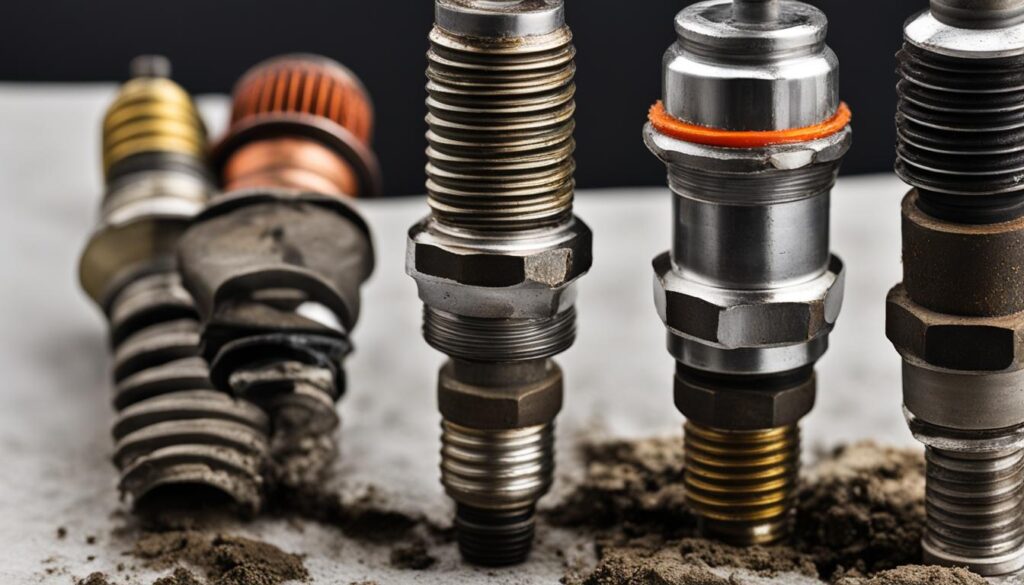Spark plugs are vital components that play a pivotal role in the functionality of internal combustion engines. They ignite the air-fuel mixture within the engine’s cylinders, initiating a controlled explosion that powers the engine and propels the vehicle forward. However, spark plugs can degrade over time and affect the engine’s performance, reliability, and fuel efficiency.
Recognizing the signs of spark plug degradation is crucial for avoiding engine damage. Common symptoms include rough idling, poor acceleration, decreased fuel efficiency, engine misfires, hard starting, poor throttle response, increased emissions, engine knocking, and a check engine light.
Spark plug degradation can be caused by normal wear and tear, carbon buildup, oil fouling, fuel additives, incorrect spark plug gap, overheating, pre-ignition or detonation, contaminants in the air-fuel mixture, excessive idling, and short trips. Regular spark plug maintenance and timely replacement are essential for optimal engine performance and longevity.
Key Takeaways:
- Spark plug degradation can lead to rough idling, poor acceleration, and decreased fuel efficiency.
- Signs of spark plug degradation include engine misfires, hard starting, and increased emissions.
- Causes of spark plug degradation include wear and tear, carbon buildup, oil fouling, and incorrect spark plug gap.
- Regular spark plug maintenance and replacement are necessary for optimal engine performance.
- Addressing spark plug degradation promptly can prevent costly engine repairs.
Factors Affecting Spark Plug Degradation
Several factors contribute to the degradation of spark plugs. Normal wear and tear is one of the main causes, as spark plugs are constantly exposed to extreme heat and pressure within the engine. Carbon buildup on the electrodes and insulator can hinder the spark’s ability to ignite the air-fuel mixture effectively. Oil fouling occurs when oil seeps into the combustion chamber and fouls the spark plugs, compromising their functionality. The use of low-quality or excessive fuel additives can also lead to spark plug fouling. Using spark plugs with an incorrect gap size can cause misfires and poor combustion.
Overheating, either due to an engine running too hot or under excessive loads, can lead to spark plug failure. Pre-ignition or detonation, caused by excessive heat or pressure, can damage spark plugs. Contaminants in the air-fuel mixture, such as dirty fuel or malfunctioning air filters, can impact spark plug performance. Excessive idling and short trips can also contribute to spark plug fouling.
Understanding these factors and addressing them can help prevent spark plug degradation and maintain optimal engine performance.
| Causes of Spark Plug Degradation | Effects on Spark Plug Performance |
|---|---|
| Normal wear and tear | Reduced spark efficiency |
| Carbon buildup | Poor ignition, misfires |
| Oil fouling | Compromised spark plug functionality |
| Fuel additives | Spark plug fouling |
| Incorrect gap size | Misfires, poor combustion |
| Engine overheating | Spark plug failure |
| Pre-ignition or detonation | Spark plug damage |
| Contaminants in the air-fuel mixture | Reduced spark plug performance |
| Excessive idling and short trips | Spark plug fouling |
Conclusion
Spark plug degradation can significantly impact your vehicle’s performance and fuel efficiency. It is crucial to recognize the signs of spark plug degradation and address them promptly to maintain optimal engine performance.
Regular spark plug maintenance, including cleaning and replacement, is essential to prevent issues and costly engine repairs. When replacing spark plugs, make sure to choose the correct heat range for your specific engine and operating conditions.
Ignoring spark plug degradation can lead to rough idling, poor acceleration, decreased fuel efficiency, engine misfires, and other mechanical issues. By understanding the causes of spark plug degradation and taking proactive maintenance steps, you can ensure the longevity and reliability of your vehicle’s engine.
FAQ
What are the common symptoms of spark plug degradation?
Common symptoms of spark plug degradation include rough idling, poor acceleration, decreased fuel efficiency, engine misfires, hard starting, poor throttle response, increased emissions, engine knocking, and a check engine light.
What causes spark plug degradation?
Spark plug degradation can be caused by normal wear and tear, carbon buildup, oil fouling, fuel additives, incorrect spark plug gap, overheating, pre-ignition or detonation, contaminants in the air-fuel mixture, excessive idling, and short trips.
Why is spark plug maintenance important?
Spark plug maintenance is important to ensure optimal engine performance and longevity. Regular maintenance and timely replacement can prevent issues and avoid costly engine repairs.
How often should spark plugs be replaced?
The lifespan of spark plugs can vary depending on the type, brand, and driving conditions. It is generally recommended to replace spark plugs every 30,000 to 100,000 miles or as specified by the vehicle manufacturer.
What are the consequences of ignoring spark plug degradation?
Ignoring spark plug degradation can lead to rough idling, poor acceleration, decreased fuel efficiency, engine misfires, and other mechanical issues. It can also contribute to more serious engine damage in the long run.




